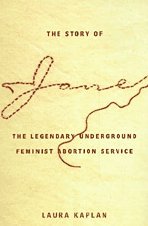Author Archives: Patricia Grossman
July 15, 2019 by Patricia Grossman
Jewish Blues Musician Elly Wininger Proves It’s Never Too Late
Elly Wininger, 2014 inductee into the NY Blues Hall of Fame, has a unique recording history among a group of versatile Jewish musicians who have wowed us with their blues singing and playing, like Mike Bloomfield of the Paul Butterfield Blues Band, Amy Winehouse, Dave Bromberg, and Bob Dylan. Even Bette Midler (“Long John Blues,” “Empty Bed Blues”) has dipped into the genre. Wininger went to her first audition at 16, was offered a recording contract, and forbidden from pursuing it by her mom. Five decades later, she’s finally been signed to a label, and she took a moment to talk to Lilith’s Patricia Grossman about her life as a singer and musician.
- 1 Comment
October 16, 2017 by Patricia Grossman
Meet the Heroes Who Performed 11,000 Abortions Before Roe v. Wade
 In the four years before Roe v. Wade legalized abortion in 1973, the Chicago-based service collective known as Jane performed 11,000 abortions. At first Jane enlisted doctors to perform the procedure, but when the collective of women found out their chief practitioner was not a doctor after all, a subset of Jane learned to perform abortions themselves, including inducing miscarriages in women with later term pregnancies. The story of Jane—how it was organized, how it evolved, and the lives it changed—is a fascinating document of a vital movement in the history of women’s rights.
In the four years before Roe v. Wade legalized abortion in 1973, the Chicago-based service collective known as Jane performed 11,000 abortions. At first Jane enlisted doctors to perform the procedure, but when the collective of women found out their chief practitioner was not a doctor after all, a subset of Jane learned to perform abortions themselves, including inducing miscarriages in women with later term pregnancies. The story of Jane—how it was organized, how it evolved, and the lives it changed—is a fascinating document of a vital movement in the history of women’s rights.
Twenty years ago, the paperback edition of The Story of Jane, by Laura Kaplan, was published. Since then, Roe v. Wade has been assaulted at all levels of government, and the book is increasingly relevant to our times.
PATRICIA GROSSMAN: When Jane first formed, how aware were its members about women’s health issues?
Laura Kaplan: Because we had been powerless, we knew nothing. When we started Jane, there weren’t any self-help books. You couldn’t go into a bookstore and get a book about women’s health. We were barred from this information. And not only were we barred from this information about our own bodies and how they worked, but were given the message that wanting to understand was somehow creepy and unseemly. Our bodies were the purview of men, including doctors, and the doctors were pretty much all men then.
- 1 Comment
August 9, 2017 by Patricia Grossman
Q&A with Author of “The Lost Letter”
 Jillian Cantor’s new novel, The Lost Letter, alternates between two very different protagonists and settings. In 1938 Austria, young Kristoff is apprenticed to a master stamp engraver, while in Los Angeles in 1989 a journalist, Katie Nelson, is in the process of getting a divorce and working out new ways of relating to her father, who has Alzheimer’s and now lives at The Willows.
Jillian Cantor’s new novel, The Lost Letter, alternates between two very different protagonists and settings. In 1938 Austria, young Kristoff is apprenticed to a master stamp engraver, while in Los Angeles in 1989 a journalist, Katie Nelson, is in the process of getting a divorce and working out new ways of relating to her father, who has Alzheimer’s and now lives at The Willows.
As radically different as these characters’ experiences are on the surface, the novel slowly discloses that they are in fact inexorably linked.
Q. Your last novel, The Hours Count, featured Julius and Ethel Rosenberg. Did you encounter historical models for your characters as part in your research for The Lost Letter?
Kristoff and the Fabers are completely fictional, but I did find stories about real engravers in Europe who came to work with the resistance and forge papers, as Kristoff eventually does. I also found different real ways stamps were used in the resistance throughout the war. For example, the British special ops forged stamps by replacing Hitler’s head with Himmler’s, hoping to cause infighting in the regime, but then they put them into circulation and no one noticed! The stamps and resistance efforts in my novel are fiction, but it did all start for me with the idea that real stamps were used in the real resistance.
Q. Stamps of a certain time and place serve beautifully to pull the various threads of The Lost Letter together. Were you certain from the beginning of the novel that you wanted to use stamps—and one particular stamp—as a pivot for your story?
The idea for the novel started with stamps, so I was certain about that much from the beginning. I was chatting with my agent one day about what I was going to write next, and she asked me if I’d ever thought about the people who illustrate postage stamps. (I hadn’t before then!) I began to do a little research about stamp engravers, stamps in WWII, and stamp collecting, and the story blossomed from there. The idea that it would be about one particular stamp came a bit later, as I was writing the first draft and plotting out the novel.
- No Comments
May 23, 2017 by Patricia Grossman
Witness to Mass Incarceration
 At the age of three, Evie Litwok used to watch her father pray. Every day, she would stick her arm out and he would put the leather strap around both their arms. Her parents were Holocaust survivors, and during the war her father had looked up to G-d and said, “If you allow me to live, I will honor you every day.” He kept his promise, davening daily, always with a smile. When Evie grew up, she was not particularly religious, attending temple only on the High Holidays. Yet the day she went to prison, she knew she wanted a siddur. She needed to pray.
At the age of three, Evie Litwok used to watch her father pray. Every day, she would stick her arm out and he would put the leather strap around both their arms. Her parents were Holocaust survivors, and during the war her father had looked up to G-d and said, “If you allow me to live, I will honor you every day.” He kept his promise, davening daily, always with a smile. When Evie grew up, she was not particularly religious, attending temple only on the High Holidays. Yet the day she went to prison, she knew she wanted a siddur. She needed to pray.
In 1995, Litwok was arrested for tax evasion and mail fraud. It took 12 years for her case to go to trial. She ended up in prison twice (2009–2011 and 2013–2014) as two counts of her charge were vacated and then retried. She had never imagined herself incarcerated, much less—for seven weeks in 2014—in solitary confinement.
- 3 Comments
November 25, 2013 by Patricia Grossman
The Courage and Criticism of a War Correspondent
 There is a remarkable visual clarity in Michele Zackheim’s “Last Train to Paris,” set predominantly in Paris and Berlin during the rise and fall of the Third Reich. Perhaps reflecting Zackheim’s background as a visual artist, the novel is as adept at crystallizing small moments as it is at portraying the sweep of action during the darkest time in 20th century Europe. The story is told by Rose (R.B.) Manon, an old woman looking back at her career as a political reporter and war correspondent for The Paris Courier.
There is a remarkable visual clarity in Michele Zackheim’s “Last Train to Paris,” set predominantly in Paris and Berlin during the rise and fall of the Third Reich. Perhaps reflecting Zackheim’s background as a visual artist, the novel is as adept at crystallizing small moments as it is at portraying the sweep of action during the darkest time in 20th century Europe. The story is told by Rose (R.B.) Manon, an old woman looking back at her career as a political reporter and war correspondent for The Paris Courier.
“With soaring lyricism, Zackheim limns an exquisitely haunting portrait of an indelibly scarred, yet deeply passionate, woman.” – Booklist
Rose’s cousin is kidnapped and then killed in Paris. In real life, the kidnapper was Eugene Weidmann, and the abductee was a distant cousin of yours. Was this a story you were familiar with as a child?
No, I learned about this story by accident when I was an adult. I was fascinated by Janet Flanner and had checked out her book Paris Was Yesterday, 1925 –1939. In it was an essay she wrote for The New Yorker that spoke about the murder.
The appearance of Colette and Janet Flanner in this novel is both natural and fun to read. Were their parts fun to write?
I loved making friends with Colette and Janet Flanner. Their involvement in my distant cousin’s murder makes them more life-like, less mysterious. When Flanner calls my cousin, “a grabby little American,” I’m upset. How dare she call my cousin, ‘grabby”! My response brings me a step closer to Flanner as a real human being, rather than an icon.
- No Comments
 Please wait...
Please wait...